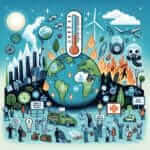The IELTS Reading section is known for its diverse range of topics and high level of difficulty. One of the more modern and relevant subjects that might appear is related to blockchain technology, especially its application in humanitarian aid. With increasing frequency, discussions on technological advancements in humanitarian sectors are appearing in IELTS Reading examinations. This topic not only tests your reading comprehension but also your ability to keep pace with contemporary issues. This article aims to provide a comprehensive reading exercise to help you prepare for such possible topics in your IELTS exam.
Reading Passage
Blockchain Technology and Its Role in Humanitarian Aid
In recent years, blockchain technology has emerged as a groundbreaking innovation with potential applications far beyond its initial use in cryptocurrencies like Bitcoin. One of the most compelling areas where blockchain is making a difference is in humanitarian aid. This technology offers a secure and transparent way to distribute resources and verify identities, which can significantly improve the efficiency and reach of humanitarian efforts.
Ensuring Transparency and Accountability
One of the primary challenges in the humanitarian sector is the lack of transparency. Traditional aid distribution methods often suffer from inefficiencies and corruption. Blockchain technology addresses these issues by creating a decentralized ledger that records every transaction. This ledger is immutable, meaning once data is entered, it cannot be altered or deleted. This ensures that all transactions are transparent and can be audited by any stakeholder, ranging from donors to beneficiaries.
Streamlining Resource Distribution
Another significant advantage of blockchain in humanitarian aid is the streamlining of resource distribution. Smart contracts, a feature of blockchain, automatically execute transactions when certain conditions are met. For example, funds can be released to a non-governmental organization (NGO) once specific milestones are achieved, such as the delivery of medical supplies. This reduces the need for intermediaries and speeds up the aid process.
Improving Identity Verification
In many humanitarian crises, verifying the identities of those in need is a critical issue. Many displaced persons lack formal documentation, making it difficult to access aid. Blockchain technology can solve this problem through digital identity systems. These systems store biometric data and other identifying information on the blockchain, providing a secure and immutable record that can be accessed globally. This ensures that aid reaches the intended recipients without delays or fraud.
Case Studies: Real-World Applications
Several organizations are already leveraging blockchain for humanitarian purposes. The World Food Programme (WFP) has implemented blockchain technology to provide food assistance to Syrian refugees in Jordan. By using a blockchain-based system, WFP has been able to reduce transaction fees, ensuring that more funds are used for direct aid rather than administrative costs.
Similarly, the United Nations has explored blockchain for various applications, from distributing financial aid to tracking the provision of essential supplies. These initiatives demonstrate the practical benefits of blockchain in increasing the efficiency and effectiveness of humanitarian aid.
 Blockchain Technology In Humanitarian Aid
Blockchain Technology In Humanitarian Aid
Questions
Multiple Choice
-
What is one of the primary benefits of using blockchain technology in humanitarian aid?
a) Increased anonymity
b) Enhanced transparency and accountability
c) Higher transaction fees
d) More complicated processes -
How do smart contracts benefit humanitarian aid distribution?
a) By adding intermediaries
b) By automatically executing transactions when conditions are met
c) By requiring manual verification
d) By reducing the speed of transactions
True/False/Not Given
-
Blockchain technology can help reduce corruption in humanitarian aid. (True/False/Not Given)
-
All humanitarian organizations currently use blockchain technology. (True/False/Not Given)
Summary Completion
Fill in the blanks using words from the passage:
Blockchain technology aids in creating a secure and (5) ledger for transactions in humanitarian aid. This ledger is (6) and helps solve the issue of (7) ___ in traditional aid distribution methods.
Answer Key
-
b) Enhanced transparency and accountability
Explanation: The passage states that blockchain technology creates a decentralized ledger that ensures all transactions are transparent and can be audited. -
b) By automatically executing transactions when conditions are met
Explanation: The smart contracts feature of blockchain helps in automating transactions based on predefined conditions, speeding up the aid process. -
True
Explanation: The text explains that blockchain can help reduce inefficiencies and corruption by ensuring transparency and immutability in transactions. -
Not Given
Explanation: While the passage mentions several organizations using blockchain, it does not state that all humanitarian organizations currently use this technology. -
transparent
-
immutable
-
corruption
Common Mistakes
- Misunderstanding the concept of “immutable.” This term means that once data is entered into the blockchain, it cannot be changed or deleted.
- Confusing the roles of different blockchain features, such as assuming that smart contracts involve manual processes when they actually automate them.
- Ignoring the importance of context in summary completion tasks. Always read the surrounding sentences to find clues.
Vocabulary
- Immutable (adjective): /ɪˈmjuː.tə.bəl/ – Unchanging over time or unable to be changed.
- Transparency (noun): /trænsˈpær.ən.si/ – The quality of being open and honest; not secretive.
- Intermediary (noun): /ˌɪn.təˈmiː.di.ə.ri/ – A person or organization that acts as a link between others to bring about an agreement or reconciliation.
- Biometric (adjective): /ˌbaɪ.oʊˈmɛt.rɪk/ – Relating to the measurement and statistical analysis of people’s physical and behavioral characteristics.
Grammar
Conditional Clauses
Type: Zero and First Conditional
Explanation: Used to describe general truths (Zero Conditional) or real future situations (First Conditional).
-
Zero Conditional: “If you use blockchain, the data is secure.”
Structure: If + present simple, present simple -
First Conditional: “Funds will be released to the NGO if specific milestones are met.”
Structure: If + present simple, will + infinitive
Tips for High IELTS Reading Scores
- Practice Regularly: Make reading a daily habit, focusing on a variety of topics.
- Expand Your Vocabulary: Learn new words in context and understand their meanings and usages.
- Develop Scanning and Skimming Techniques: Quickly locate information without reading every word.
- Practice Different Question Types: Familiarize yourself with the range of question types found in the IELTS Reading section.
- Work on Time Management: Aim to complete each section within the allocated time to avoid rushing through the last passage.
By incorporating blockchain in humanitarian aid, we witness not only an evolution in technology but also in how we perceive transparency and efficiency in aid distribution. This topic presents a rich source of material for IELTS Reading preparation, combining current events with technical and practical knowledge. Happy studying, and good luck on your IELTS journey!

